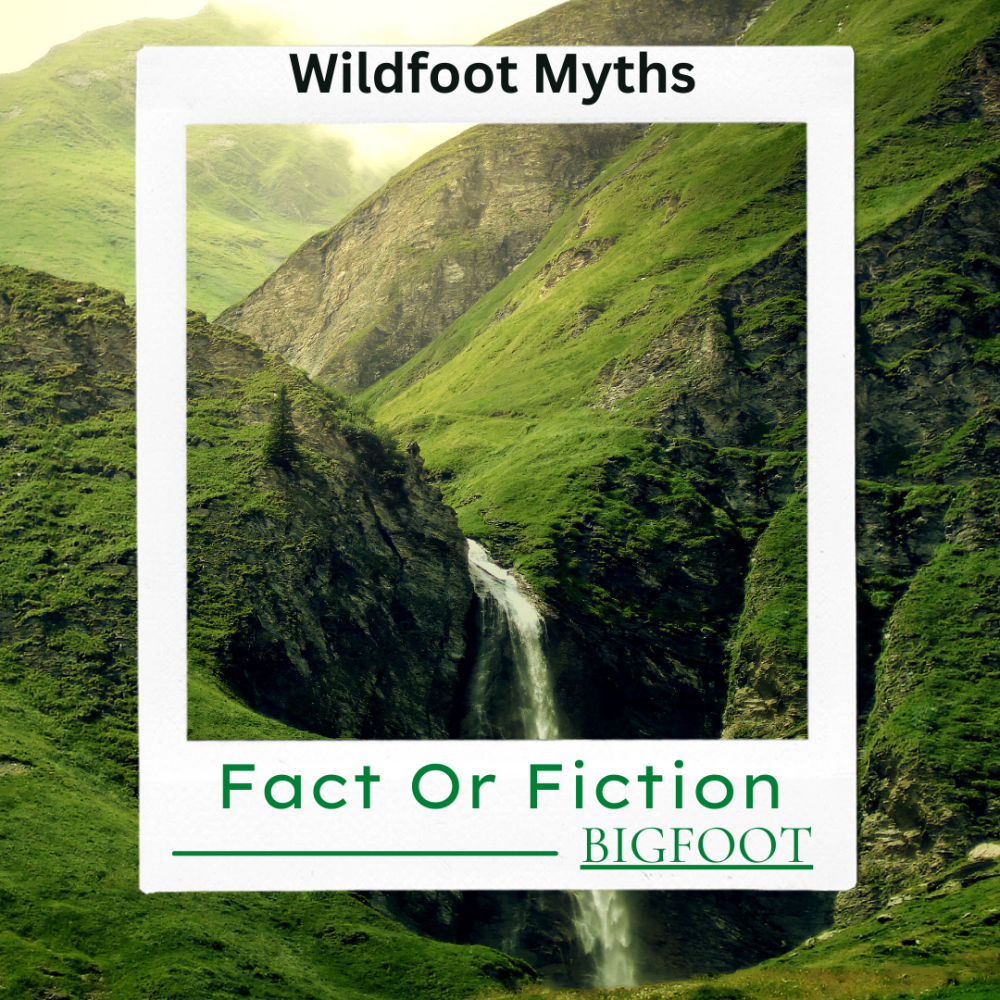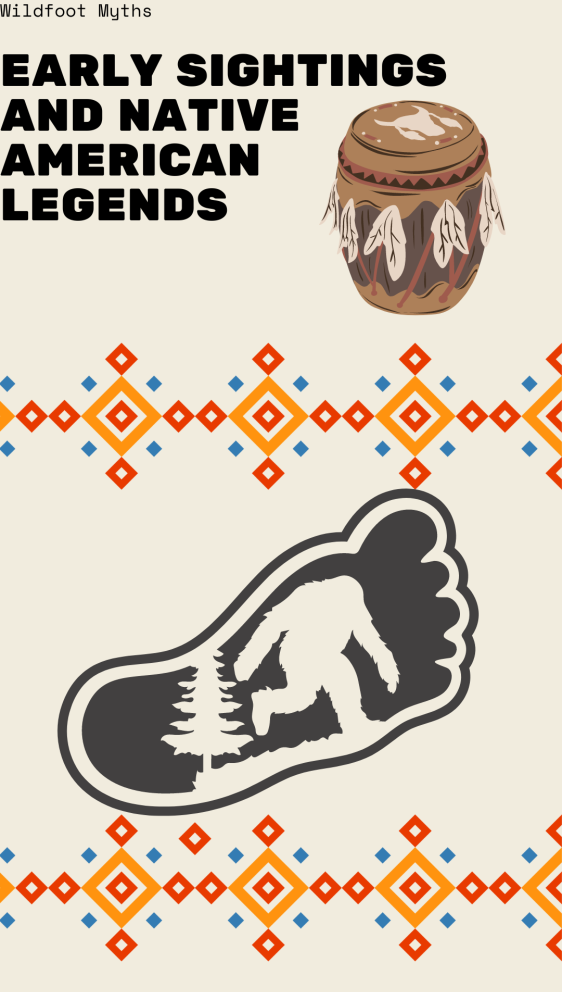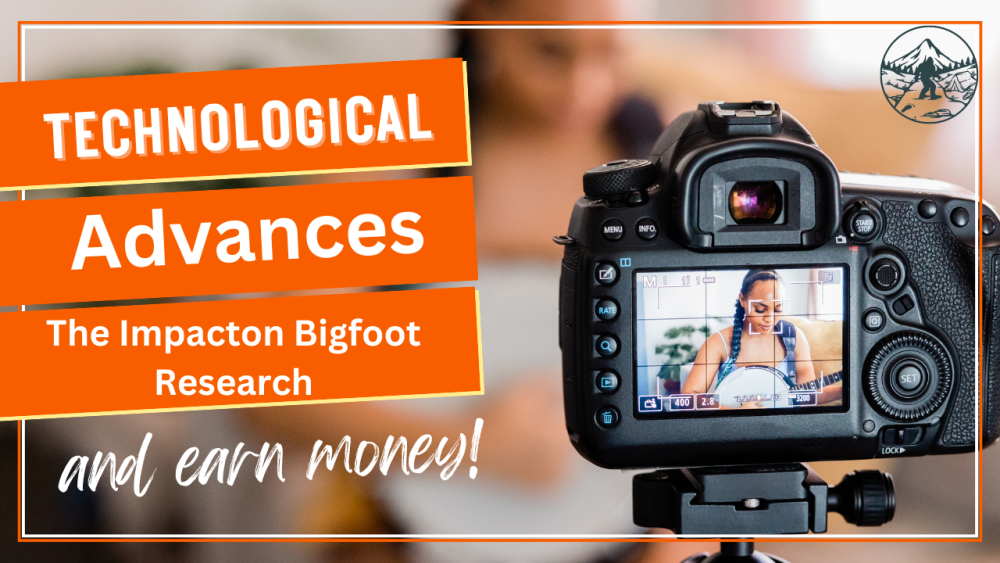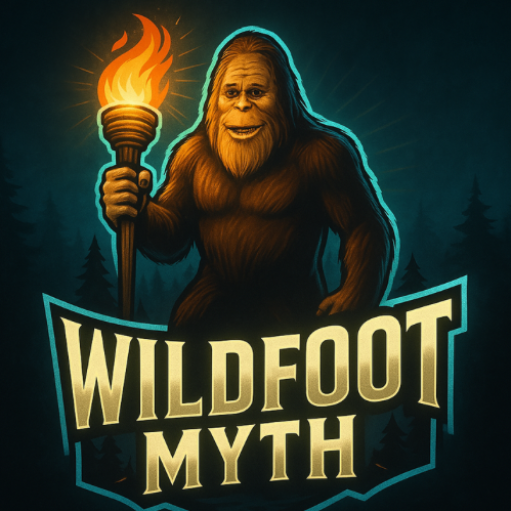
I’m going to take you all on a journey with this blog! We are going to walk through an unbelievable story on Bigfoot, we will also touch base on some great history with Native American Legends.
Followed by some Investigations and Skepticism, Then we will walk through Modern Sightings and Evidence as well as touch a bit on Psychological and Sociological Aspects. With so much more. But before we get started on this WildFoot Myths adventure. I would like to.
DISCLOSURE:
All of my posts on this website do contain affiliate links. They will lead you to other blogs i have written about Bigfoot Stories. There are also Amazon Products links on this Blog.
So If you click on any link and make a purchase, As an Amazon Associate I earn from qualifying purchases. It is also at no additional cost to you to explore these links.
Now lets enjoy the article !!
Bigfoot is a ginormous mystery wrapped in an enigma coated with fur. This colossal creature, often described as a hairy, bipedal humanoid, has captured the imagination of people worldwide. Some folks swear they’ve seen it lurking in the shadows of dense forests, while others think it’s just a big tale spun by storytellers with a wild imagination.
Bigfoot sightings date back centuries. Native American tribes across North America have legends of a giant, wild man of the woods. Names like Sasquatch and Skookum are often exchanged around campfires, keeping the legend alive. These stories aren’t just casual fireside chatter; they’re deeply woven into the cultural fabric, hinting at something more than mere myth.
As explorers began to wander deeper into unknown territories, the stories of Bigfoot became more widespread. Early settlers and frontier explorers shared tales of strange encounters in the deep woods. The legend grew with every retelling, picking up new details and variations along the way. Before long, Bigfoot had cemented its place in folklore.
Fast forward to today,
The legend has only grown more intriguing. What is it about Bigfoot that keeps us hooked? Maybe it’s the allure of the unknown, the thrill of a potential discovery. Or perhaps it’s the sheer fun of imagining something so extraordinary lurking just out of sight. In any case, whether you’re a believer or a skeptic, Bigfoot remains a fascinating puzzle that continues to spark curiosity and debate.
Check out these great blogs I wrote !!
The Psychology Of Belief: Why Do People Believe In Sasquatch
 Early Sightings and Native American Legends
Early Sightings and Native American Legends
Long before Bigfoot grabbed headlines and became a pop culture sensation, it roamed the tales and legends of Native American tribes. They didn’t just talk about Bigfoot like it was some campfire ghost story; they ingrained it in their cultural lore. Different tribes had various names for the creature, such as Sasquatch and Skookum, each steeped in rich, descriptive narratives. These aren’t just casual mentions but deeply rooted beliefs that painted Bigfoot as a massive, powerful being.
One look at the stories from these tribes, and you get the sense that Bigfoot sightings have been happening for ages. Native American artwork and oral traditions depict a creature that matches up scarily well with modern descriptions. That consistency is one reason the legend persists so strongly even today.
The 19th and early 20th centuries
Brought more tangible sightings. Pioneers and explorers started documenting what they saw and experienced in the vast, uncharted American wilderness. Some of their accounts almost read like adventure novels, filled with suspenseful encounters with a mysterious, upright creature covered in hair. It’s clear they were encountering something they couldn’t easily explain away.
Cultural legends play a huge role in shaping the way we see Bigfoot today. It’s like these early stories set the groundwork for what we now consider a modern myth. They provide a kind of historical backing that keeps the legend of Bigfoot as captivating as ever.
Check out this great blog I wrote !!
Uncovering The Truth Behind Sasquatch In Canada

Scientific Investigations and Skepticism
Scientists have not been sitting on their hands when it comes to Bigfoot. Various scientific studies have attempted to get to the bottom of this mystery, with researchers taking to forests armed with cameras, audio equipment, and even DNA kits. They’ve set up lab tests, analyzed strange hair samples, and pored over grainy footage, all in a quest to take Bigfoot from legend to reality.
Yet,
The scientific community remains divided. Many experts argue that the evidence collected so far is shaky at best. Bigfoot enthusiasts have presented blurry photos, inconclusive footprints, and dubious audio recordings, none of which meet the rigorous standards of scientific proof. Skepticism is rampant, and it’s easy to see why. Without concrete proof, many scientists are more likely to attribute Bigfoot sightings to hoaxes or misidentifications of known animals.
The methodology behind debunking myths is pretty straightforward. Every potential piece of evidence gets scrutinized with a fine-toothed comb. Hair samples often turn out to be from bears or other animals, and footprints are sometimes the work of pranksters hoping to cash in on Bigfoot fever. Even supposed audio evidence—those eerie howls and tree knocks—can be mimicked by various wildlife and environmental sounds.
This divide between believers and skeptics creates an intriguing dynamic. On one hand, you have dedicated researchers who won’t rest until they prove Bigfoot is the real deal. On the other, you have scientists and skeptics devoted to setting the record straight, ensuring that fantastical claims are backed by solid evidence. The back-and-forth keeps the conversation lively and ongoing.
Despite the overwhelming skepticism,
There’s no denying that the chase for Bigfoot has sparked serious scientific curiosity. The quest has led to genuine advancements in fields like wilderness tracking, environmental DNA collection, and the study of rare species. Whether Bigfoot is ultimately proven to exist or not, the search itself pushes scientific boundaries in ways that benefit all fields of study.
Check out this great blog I wrote !!
The Role of Media and Pop Culture
Media has a knack for turning whispers into megaphones, and Bigfoot is no exception. From movies and TV shows to books and podcasts, Bigfoot has morphed into a larger-than-life figure. You’d be hard-pressed to find someone who hasn’t heard of this elusive giant, thanks in large part to its media presence.
The film that arguably lit the fire was the infamous Patterson-Gimlin film from 1967. This short clip, showing what appears to be a Bigfoot striding through the forest, has been dissected, analyzed, and debated for decades. Whether you believe it’s real or a hoax, there’s no denying its impact on Bigfoot’s reputation.
Television got in on the action with shows like “Finding Bigfoot” and “Expedition Bigfoot.” These programs mix adventure and investigation, keeping viewers on the edge of their seats and eager for the next clue. Even skeptics find it hard to resist the suspense and intrigue these shows create.
Books and documentaries have taken more scholarly and investigative approaches. Authors and filmmakers comb through mountains of evidence, interview countless eyewitnesses, and analyze every piece of footage available. The result is a wide range of perspectives—from hardcore believers to diligent debunkers—making it clear that Bigfoot isn’t just a myth; it’s a phenomenon worthy of deep exploration.
Media doesn’t just build up the legend; it also exposes hoaxes. Famous frauds, like the costume-wearing ‘Bigfoot’ from the Georgia Bigfoot Hoax in 2008, quickly make headlines and spread like wildfire. These incidents provide a reality check, reminding us that not everything we see or hear can be taken at face value.
Pop culture’s enthusiasm for Bigfoot has definitely shaped public perception. Some people are true believers, their faith in Bigfoot unshakable despite the lack of hardcore evidence. Others enjoy the myth as a fantastic story, a conversation starter about the wonders and mysteries of our world. Either way, media keeps Bigfoot alive and kicking in our collective imagination.
Check out these Link if you follow them they will take you to some amazon Books on Investigations and Skepticism that i found very interesting !!

Notable Modern Sightings and Evidence
In recent years, Bigfoot sightings have continued to capture the public’s imagination. High-profile encounters keep surfacing, each one adding fuel to the fire. One notable example is the 2000 Skookum Cast, which some believe shows a partial body imprint of Bigfoot left in a muddy area in Washington State. While the casting provided intriguing evidence, it’s still not universally accepted as definitive proof.
Then there’s the audio evidence.
Bigfoot enthusiasts have recorded mysterious howls and knocks in forests, claiming these sounds can’t be explained by known local wildlife. These recordings are dissected with advanced software to filter out potential sources but still remain contentious. Some experts suggest that the sounds could emanate from other animals or even environmental factors like echoing tree branches or wind.
Visual evidence
remains the most sought-after aspect. High-resolution photography and video clips frequently get uploaded online. However, these images often suffer from the same issues: low quality, ambiguous subjects, and the highly questionable contexts in which they are taken. Despite the limitations, these visuals captivate imaginations and keep the hunt alive.
Physical evidence,
Such as hair samples and footprints, also continues to be a hot topic. Labs frequently analyze submitted hair samples, only to determine they belong to known species like bears or deer. Footprints, although compelling at face value, often turn out to be inconclusive due to the risk of being fabricated.
Interviews with eyewitnesses
offer another layer of insight, though they come with their own set of challenges. People recounting their experiences can be highly convincing, but human memory is notoriously unreliable. Without concrete proof to back their claims, these accounts remain captivating but not conclusive.
The treasure trove of modern sightings and evidence keeps the conversation alive and well. Each new piece of evidence, regardless of its credibility, adds another layer to the complex puzzle that is Bigfoot. Whether any of this will ever prove Bigfoot’s existence is still up for debate, but it certainly keeps the curiosity burning.
Psychological and Sociological Aspects
Why do some people fervently believe in Bigfoot while others dismiss it as pure fantasy? Psychology and sociology might have the answers. On the psychological front, the concept of ‘Bigfoot’ taps into fundamental human fears and curiosities. It’s the unknown lurking just beyond the campfire light, a modern-day boogeyman that evokes a primal sense of wonder and fear.
Confirmation bias plays a considerable role here. Once someone believes in Bigfoot, they’re more likely to interpret ambiguous sounds, sights, or experiences as evidence supporting that belief. This bias is self-perpetuating and makes it difficult for skeptics to dissuade convinced believers. If you already think Bigfoot is real, that rustling in the woods isn’t just wind; it’s a sign.
From a sociological perspective,
Bigfoot is a fascinating social phenomenon. In communities near supposed sighting hotspots, the legend of Bigfoot often blends seamlessly into local culture. Some towns even capitalize on the legend, building tourism around Bigfoot festivals, museums, and guided expeditions. The legend doesn’t just survive; it thrives, weaving its way into the fabric of community identity.
Collective belief is powerful. When a community shares a common legend, it strengthens social bonds and creates a sense of belonging. It’s not just about whether Bigfoot exists; it’s about shared experiences and stories that bring people together. These tales become part of the community’s history, passed down through generations.
On a broader scale,
Bigfoot serves as a social Rorschach test, reflecting broader societal anxieties and desires. In a rapidly changing world filled with technological advances and urbanization, people may find comfort in the idea of an untamed wilderness hiding elusive creatures. Bigfoot represents a link to a mysterious, unexplored world, offering an escape from the routines and demands of modern life.
The emotional and psychological investment people have in Bigfoot is significant. For believers, dismissing Bigfoot isn’t just rejecting a creature; it’s dismissing a part of their identity or something that gives them joy and wonder. For skeptics, debunking Bigfoot can feel like a crusade for rationality and evidence-based belief. Both sides are deeply invested, keeping the debate lively and inclusive.
Check out this great blog I wrote !!

Technological Advances and Their Impact on Bigfoot Research
Modern technology has upped the ante in the search for Bigfoot. Gone are the days of grainy photos and shaky video footage. Now, researchers are hitting the wilderness equipped with cutting-edge tools like drones, trail cameras, and environmental DNA analysis kits. These advancements have the potential to provide clearer, more definitive evidence—if it’s out there to be found.
Drones
Offer a bird’s-eye view of inaccessible terrains, covering vast areas quickly and capturing high-resolution images and videos. With drone technology, researchers can explore remote regions without physically being there, reducing human interference that might scare off elusive creatures.
Trail cameras
Are another popular tool. These motion-activated cameras can be left in strategic locations for extended periods, capturing activity around the clock. Unlike human observers, these cameras remain undetected, making them ideal for monitoring wildlife and, hopefully, spotting Bigfoot.
Environmental DNA (eDNA)
is one of the most exciting advancements. By collecting samples from soil, water, or even air, scientists can analyze the genetic material left behind by organisms. This means that even without seeing Bigfoot, his presence could be detected through eDNA. However, identifying unknown species from these samples remains a challenge, given the vast array of genetic material present in a sample.
Despite the tech advantages, there are still hurdles to clear. Nature itself poses significant challenges. Dense forests, diverse wildlife, and environmental conditions all complicate the tracking and identification process. Plus, the interpretation of gathered data is often contentious and needs cross-verification from multiple scientific disciplines.
Nevertheless, these advancements have brought a new level of rigor to Bigfoot research. The hope is that technology might yield that elusive piece of incontrovertible evidence that could sway skeptics and validate the experiences of believers. Until then, the pursuit continues with an ever-improving toolkit.
Have a look at some of the top Gear to use in this Blog i wrote !!

Conclusion: Fact, Fiction, or Somewhere In Between?
The saga of Bigfoot is far from over. With a rich history steeped in ancient legends and modern sightings, it’s clear that Bigfoot has a significant place in our collective consciousness. From early Native American stories to tabloid headlines, Bigfoot continues to be a figure that fascinates and divides.
Scientific skepticism
Remains a strong counterpoint to the claims of believers. While no irrefutable evidence has emerged, the chase for Bigfoot has led to innovations in wildlife tracking and has kept the spirit of exploration alive.
Media,
plays its part in stoking the fire of Bigfoot curiosity. Whether through TV shows, documentaries, or books, the legend is continuously examined, questioned, and celebrated. Each new piece of potential evidence, whether analyzed through the lens of science or storytelling, adds a fresh layer to this enduring mystery.
Psychologically and sociologically,
Bigfoot taps into our most basic human instincts. The idea of an unknown creature walking among us sparks excitement and wonder, while also fostering community bonds and collective narratives.
The introduction of advanced technologies
Like drones and eDNA analysis has added new dimensions to the hunt for evidence. Even as these tools become more sophisticated, the elusive proof of Bigfoot’s existence remains just out of reach. Yet, they bring researchers closer to the truth with each passing day.
So where does this leave us?
Whether you’re a believer or a skeptic, the legend of Bigfoot serves as a reminder of the mysteries our world still holds. It encourages curiosity, critical thinking, and a sense of adventure—qualities that are invaluable in any exploration, scientific or otherwise. The journey to uncover the truth about Bigfoot is still very much alive, filled with more questions than answers, and that’s what makes it so compelling.
This link will take you to :
Find more great stories check out this 30 day free trials with Kindle Unlimited
Thanks for stopping by i hope you enjoyed all the great information and links feel free to comment & Share
Be safe out there !!

Hey a interesting post you have here!
The big foot sighting has been told everywhere and to this day has got many spectating if it is real or not! I remember when we had a whole class lesson on the big foot sighting and thought it was quite interesting, still unsure whether to believe it or not. There has not been no further sightings so I am wondering if this mystery is just a myth which humans would love to keep going along with.
Thanks again and have a great day!
Hi Sariya
Thanks for the great comment, That would have been a very interesting class
I have always Believed that Sasquatch is real because i have come across evidence and where i was there are not many people that far into the wilderness to be playing a prank. So years ago way back in the early flip phone days when i came across a footprint that was crossing a path i was walking down. it was a site to see that for sure.
I was way out in the back country by Beaver Mines Just a breath taking place to be. With amazing blue skies filled with white clouds overlooking Large mountains surrounding a base of dark beautiful green rows of trees for miles, Well Centered by a gorgeous light blue lake.
But that’s where the magic happened for me, And maybe you will need to see it in person to fully believe. That’s totally cool,
Yes your totally right in the USA was 2023 and the last report for Canada was 2020
Thanks again
stay safe